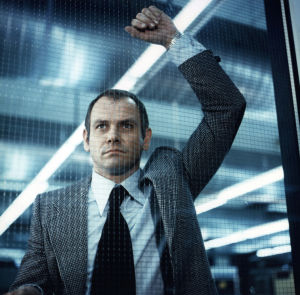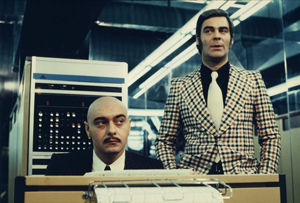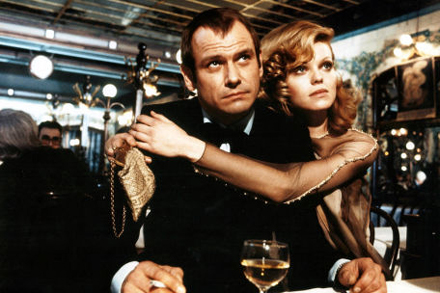|
|
Reviewed by Glenn Erickson
Most everything I've read about Rainer Werner Fassbinder's World on a Wire (Welt am draht) concentrates on the provocative German director, but this highly unusual TV drama needs to be addressed as an important effort in science fiction filmmaking. Shown only twice on West German television in the 1970s and revived only once or twice at Fassbinder career retrospectives, the lengthy (three hours, 32-minute) film was practically forgotten before its 2010 restoration and revival. Criterion's Blu-ray was released early in 2012, and it's taken this writer some time to absorb it all.
Science fiction filmmaking is at a disadvantage when it makes specific predictions about future trends and events. When time overtakes the particular prophecies of a sci-fi picture, the general audience can forget the author's still-relevant theme and declare the whole picture obsolete. Forbidden Planet now elicits unearned chuckles when a narrator announces that man didn't land on the moon until the end of the 21st century. Mentions of Kubrick's 2001 are beginning to harp on apologies for the fact that the future world of the millennium didn't work out just as Kubrick and Clarke imagined it in 1968. And when fellow Neuer Deutsche Film director Wim Wenders personally introduces his masterpiece Until the End of the World in special screenings, he all but apologizes that his world of 1999 (made in 1991) completely missed the advent of The Internet. Well, who did predict the Internet?
Most everyone will agree that the book 1984 can no longer be successfully filmed. Every idea, narrative invention and detail in George Orwell's dysfunctional utopia has been borrowed and copied so often, that they have been effectively used up. Do a faithful version of 1984 and there will be people complaining that you've re-made Brazil, but without the jokes.

A Halloween skit in the TV show The Simpsons had young Lisa yawn in boredom at the sight of a Time-Space dimensional porthole in the wall of her house. What was once an outlandishly bold concept had become a ho-hum feature of far too many sci-fi thrillers. But nobody remembers the original film to introduce the idea. The impressive ideas in Fassbinder's World on a Wire possibly originated in books by Philip K. Dick, and have since become familiar from over-use in pictures like The Matrix. Because of that, World on a Wire no longer has the same suspense factor that impressed the German television audience in 1973. As soon as it is revealed that a computer programmer has created a virtual world inhabited by 9,700 "Identity Units" that don't know they're artificial beings, we can easily guess the next plot complication: the creators of the virtual world realize that they themselves might be virtual creations, programmed and controlled by a higher level of researchers. Where does this conceptual hall of mirrors end?
Science fiction film has come up with some effective symbolic correlatives to communicate the paranoid underpinnings of the post-bomb scientific era. One can no longer make an entertaining thriller about people being possessed by aliens, for we all know the standard signifiers that a character is under the remote control of malignant forces -- too-calm eyes, robotic motions. Nor can one propose a movie in which robots look just like people, unless everyone is a suspected robot until proven otherwise. This is just one of the reasons why the effective haunted house spaceship movie Alien is basically very stupid -- everybody in the future society knows that androids exist, yet they're shocked when a character is revealed to be one?

The longer format of World on a Wire allows director Fassbinder to ease his characters into a paranoid situation where even the supposed villains can't be certain who is really pulling the strings (wires?). At IKG (The Institute for Cybernetics and Future Science), Professor Henri Vollmer (Adrian Hoven) dies before he can tell IKG's security chief Lause (Ivan Desny) some world-changing secret about their virtual computer world program (which has been created to predict trends and events in the future). When Vollmer's assistant Fred Stiller (Klaus Löwitsch) becomes the new technical director, Lause seemingly disappears before his very eyes. Soon nobody remembers Lause, and news reports of his death have also disappeared from the newspapers. Working in tandem with the programmer Walfang (Günter Lamprecht), Stiller is forced to cross over between reality and the virtual world. Stiller dons a helmet to enter the virtual world and contact Identity Unit 0001, named Einstein (Gottfried John of Goldeneye). Einstein is the only Identity Unit who knows the truth about himself. Desperate to break out (or UP to the next level), he finds a way to switch identities with Walfang. Meanwhile, Fred Stiller is disturbed to find that his boss Siskins (Karl Heinz Vosgerau) has a crooked scheme going to share predictions from the virtual world with a steel company. As doing so violates the project's idealistic mission, Stiller becomes convinced that he will be the next person murdered or driven mad by Siskins, in league with Mark Holm (Kurt Raab), a new employee from the steel company. Who can Fred turn to? Any of his colleagues could be part of the conspiracy, and many of them act very oddly. Can he trust Rupp (Ulli Lommel), a doubting news reporter? Oddest of all is Vollmer's daughter Eva (Mascha Rabben). She keeps asking Fred to trust her, yet behaves like a shifty femme fatale.
Although World on a Wire's biggest revelation comes at the end of part one of this show, we see it coming from almost the very first scene. Too many subsequent movies have used the same device. It's basically the same jolt to one's personal identity that happens in the popular hit Blade Runner and can be traced back to the concept-rich Creation of the Humanoids. The way identities can be shifted across dimensions from body to body is rather similar to the concept of Avatar. Fassbinder's film has its own Philip K. Dickian- absurdities. At one point the head of IKG is amused by when he watches a Television view of his 'copy' in the virtual dimension: the simulacrum is performing a theatrical song and dance in a variety show. Yet, the most surprising thing about Fassbinder's film is that its allusions to philosophical theory are not just there to lend an intellectual veneer to the proceedings. When the characters reference Plato, there's a direct relevance to the situation on screen.

Don't expect what passes for glitz and eye candy in the newer sci-fi films. World on a Wire's action scenes are subordinated to the mystery investigation. We see a couple of fights, a car crash or two and a foot chase shot reminiscent of Invasion of the Body Snatchers. The most chilling murders are committed by performing a 'program deletion' protocol on a computer keyboard. Like a noir private eye, Stiller tries to make sense of perplexing events that seem to be closing in on him. His colleagues behave strangely and his superior is annoyingly supercilious. Fred feels as if he's fast becoming an irrelevance, scheduled for elimination. "Living in a virtual world" seems very much like working as a pawn in a modern corporation.
Rainer Werner Fassbinder brings a directorial point of view to World on a Wire that alters every scene. Standard sci-fi exposition is downplayed and the visuals are cluttered with reflections and mirror images. These are easily interpreted as evoking the labyrinth of alternate realities that the scientists have created. Many sets have glass walls and mirrored surfaces that are constantly fragmenting the screen into odd shapes, with characters speaking but seemingly not directly to each other. Professor Vollmer begins by annoying a government minister with a pocket mirror, and talking in riddles about illusion versus reality. In an on-going stage act with a Marlene Dietrich impersonator (Solange Pradel), Fassbinder replays the final scene of Von Sternberg's Dishonored, in which Dietrich is Mata Hari. Preparing to be executed by firing squad, "Mata" checks her reflection in the mirrored surface of a soldier's saber. The director doesn't miss a trick with his mirror games.
Fassbinder seems to have burned up his entire life's creative energy in just fifteen years. We recognize some of the actors from his many other movies, but Criterion's extras show us that a couple of dozen supporting roles are covered by TV and film actors that Germans would instantly recognize. Christine Kaufmann as a somnambulistic party guest. A secretary's strange half-smile makes her look like a possessed zombie, a pose adopted by several other characters. A replacement secretary (Barbara Valentin) receives second billing. She sometimes affixes a disturbingly neutral expression on her face as well, just as the big boss Siskins always carries a sardonic half-grin. Is this just corporate behavior, or evidence of simulacra programmed at an inadequate bit rate? Fred Stiller tries to enlighten some associates at a bar about his suspicious that they may be digital illusions, manipulated by people at a higher level. All he discovers is that humans will do almost anything to avoid questioning basic assumptions about the nature of their existence. People will band together to punish anyone who insists on an alternate explanation of reality.

World on a Wire is filmed in 16mm and looks it, even with the elaborate camera moves and mirror-conscious compositions. As the '70s fashions and interiors have gone almost completely out of favor, Klaus Löwitsch's noir-ish suits and hats are a welcome break. Fassbinder uses almost no conventional special effects. A computing room has a barely adequate array of B&W TV screens that don't begin to suggest their function of a look-in on the alternate virtual reality. It doesn't matter. A slightly futuristic cityscape is created by filming exteriors in unfamiliar parts of Paris, as Godard did with Alphaville (please, Criterion, an upgrade for Lemmy Caution!). The superior script, compelling actors and refreshing direction are what keep us interested in World on a Wire for a full 3.5 hours. It has the interest factor of other somewhat-forgotten sci-fi TV productions that need to be revisited: the 1980 PBS production of Ursula K.Le Guin's The Lathe of Heaven, the 1980 NBC production of Aldous Huxley's Brave New World.
The Criterion Collection's Blu-ray of World on a Wire (Welt am draht) is a fine encoding of this 'iffy' 16mm production. The 2010 restoration apparently had some problems here and there, as one scene in a dark room looks heavily posterized, and not on purpose. In general colors are not particularly exciting, leading us to wish that the show could have been filmed in 35mm. Perhaps time was a factor; the extras mention an abbreviated shooting schedule. Interestingly, in one of the documentaries we see the show being color-timed in a post-production house. It's projected on a screen in cropped widescreen format. Criterion's transfer is flat, with plenty of foot room on the bottom. Did it look too grainy with the additional enlargement? Or was Criterion being orthodox and trying to maintain the original TV framing?

The audio is excellent, giving us a chance to appreciate Fassbinder's unusual music choices, and the electronic noises he uses to suggest that first Vollmer and then Stiller are being bombarded by migraine headache interference. Vollmer says that he thinks his head might explode, a statement that will cause 1,001 sci-fi fans to immediately flash forward to Cronenberg's Scanners (coming soon from Criterion).
World on a Wire can say goodbye to obscurity, as the nearly hour-long documentary Looking Ahead to Today is a comprehensive making-of show, featuring one of the actors and Fassbinder's co-screenwriter talking about the project. Cameraman Michael Ballhaus filmed a pack of Fassbinder pictures and by way of John Sayles and others soon became one of the more popular Hollywood cameramen. German film expert Gerd Gemünden offers a perceptive and insightful analysis of the film. In addition to a 2010 restoration theatrical trailer, the insert booklet contains an essay by critic Ed Halter.
The source book Simulacron-3 by Daniel F. Galouye was adapted again for the 1999 cyber thriller The Thirteenth Floor. It stresses the crime angle and treats the virtual environment almost as a 'holodeck' to which people can freely come and go. World on a Wire is said to be remarkably faithful to the Galouye book. It's definitely not a typical Fassbinder show, and as such it shows him readily adaptable to a very tough subject. He joins Joseph Losey, François Truffaut, Jean-Luc Godard, Wim Wenders and Bertrand Tavernier as a maker of classy, progressive science fiction.
On a scale of Excellent, Good, Fair, and Poor,
World on a Wire Blu-ray
rates:
Movie: Excellent
Video: Very Good
Sound: Excellent
Supplements: Interview with German film scholar Gerd Gemünden, 50-minute making-of documentary from 2010, trailer for 2010 release; booklet with an essay by film critic Ed Halter
Deaf and Hearing-impaired Friendly?
YES; Subtitles: English
Packaging: Keep case
Reviewed: June 22, 2014

Text © Copyright 2014 Glenn Erickson
See more exclusive reviews on the Savant Main Page.
The version of this review on the Savant main site has additional images, footnotes and credits information, and may be updated and annotated with reader input and graphics.
Return to Top of Page
|



